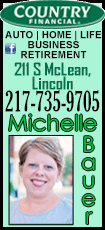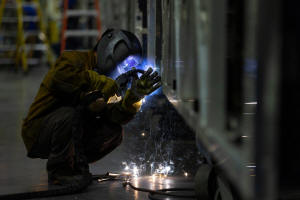Tight U.S. labor market keeps upward pressure on wages; inflation heats
up
 Send a link to a friend
Send a link to a friend
 [July 30, 2022] By
Lucia Mutikani [July 30, 2022] By
Lucia Mutikani
WASHINGTON (Reuters) - U.S. labor costs
increased strongly in the second quarter as a tight jobs market boosted
wage growth, which could keep inflation elevated and give the Federal
Reserve cover to continue its aggressive interest rate hikes.
Other data on Friday showed consumer spending accelerating in June,
though the uptick was tied to higher costs for gasoline as well as a
range of other goods and services, with monthly prices surging by the
most since 2005. Soaring inflation contributed to the economy's 1.3%
contraction in the first half of this year, leaving it on the brink of a
recession.
"The Fed will continue to grapple with trying to tame inflation without
tipping the economy into a recession," said Dante DeAntonio, an
economist at Moody's Analytics in West Chester, Pennsylvania "The data
on wage and price growth will not do them any favors as upward pressure
clearly remains even as the overall economy has weakened."
The Employment Cost Index, the broadest measure of labor costs,
increased 1.3% last quarter after accelerating 1.4% in the January-March
period, the Labor Department said. Economists polled by Reuters had
forecast the ECI would rise 1.2%.

Labor costs surged 5.1% on a year-on-year basis, the largest rise since
the current series started in 2001, after rising 4.5% in the first
quarter. Inflation, however, eroded the gains. Inflation-adjusted labor
costs fell 3.6% on a year-on-year basis.
The ECI is widely viewed by policymakers and economists as one of the
better measures of labor market slack and a predictor of core inflation,
as it adjusts for composition and job-quality changes. Data on Thursday
showing the economy contracted again in the second quarter led
economists and investors to believe that the Fed would slow its pace of
rate hikes in September.
The U.S. central bank on Wednesday raised its policy rate by another
three-quarters of a percentage point. It has now hiked that rate by 225
basis points since March.
Employment costs were fueled by strong wage gains. Wages and salaries
shot up 1.4% after rising 1.2% in the first quarter. They were up 5.3%
on a year-on-year basis, also the largest rise since the current series
began in 2001.
The private sector was the main driver of the increase, with wages and
salaries there notching a 1.6% increase, up from 1.3% in the
January-March period.
The advance in wages occurred across all industries, with hefty gains in
the traditionally low-paying leisure and hospitality sector as well as
retail industries. Private sector wages rose 5.7% from a year ago, also
the biggest gain in the series.

Stocks on Wall Street were trading higher following upbeat forecasts
from Apple and Amazon. The dollar slipped against a basket of
currencies. U.S. Treasury prices were mixed.
TUG OF WAR
There were 11.3 million job openings at the end of May, with nearly two
open positions for every unemployed person.
[to top of second column] |

A welder works while building a bus frame at the BYD electric bus
factory in Lancaster, California, U.S., July 1, 2021. REUTERS/Mike
Blake

A slowdown in annual growth in average hourly earnings in the first half of the
year had raised expectations of a peak in wage gains. Benefits increased 1.2% in
the second quarter and were up 4.8% on a year-on-year basis.
"The second-quarter employment cost data doesn't provide any evidence that wage
growth is slowing and leaves the Fed on track to lift the funds rate another 75
basis points at its September meeting," said Nancy Vanden Houten, lead U.S.
economist at Oxford Economics in New York.
In a separate report on Friday, the Commerce Department said consumer spending,
which accounts for more than two-thirds of U.S. economic activity, rose 1.1%
last month after gaining 0.3% in May. Economists had forecast consumer spending
would accelerate by 0.9%.
The data was included in the advance gross domestic product report for the
second quarter, published on Thursday. The economy contracted at a 0.9%
annualized rate last quarter after shrinking at a 1.6% pace in the first
quarter.
Consumer spending last month was inflated by higher prices for gasoline and
other energy products. Consumers also spent more on healthcare and motor
vehicles.
The higher costs boosted the personal consumption expenditures (PCE) price index
1.0% last month. That was the largest increase since September 2005 and followed
a 0.6% gain in May. In the 12 months through June, the PCE price index advanced
6.8%, the largest increase since January 1982. The PCE price index rose 6.3% on
a year-on-year basis in May.
Excluding the volatile food and energy components, the PCE price index shot up
0.6% after climbing 0.3% in May. The so-called core PCE price index increased
4.8% on a year-on-year basis in June after rising 4.7% in May.

These measures are closely tracked by Fed officials for the central bank's 2%
inflation target. There are, however, signs that inflation could be peaking. A
third report from the University of Michigan on Friday showed consumers'
inflation expectations slipped in July.
Soaring prices in June saw inflation-adjusted consumer spending rebounding by a
feeble 0.1% after falling 0.3% in May. This puts consumer spending on a weak
growth trajectory heading into the third quarter after rising at its slowest
pace in two years in the April-June quarter.
"The tug of war on consumer purse strings is slowly being won by the bad guys,
high inflation, rising borrowing costs, and dismal confidence," said Sal
Guatieri, a senior economist at BMO Capital in Toronto.
(Reporting by Lucia Mutikani; Editing by Paul Simao)
[© 2022 Thomson Reuters. All rights
reserved.]This material may not be published,
broadcast, rewritten or redistributed.
Thompson Reuters is solely responsible for this content. |